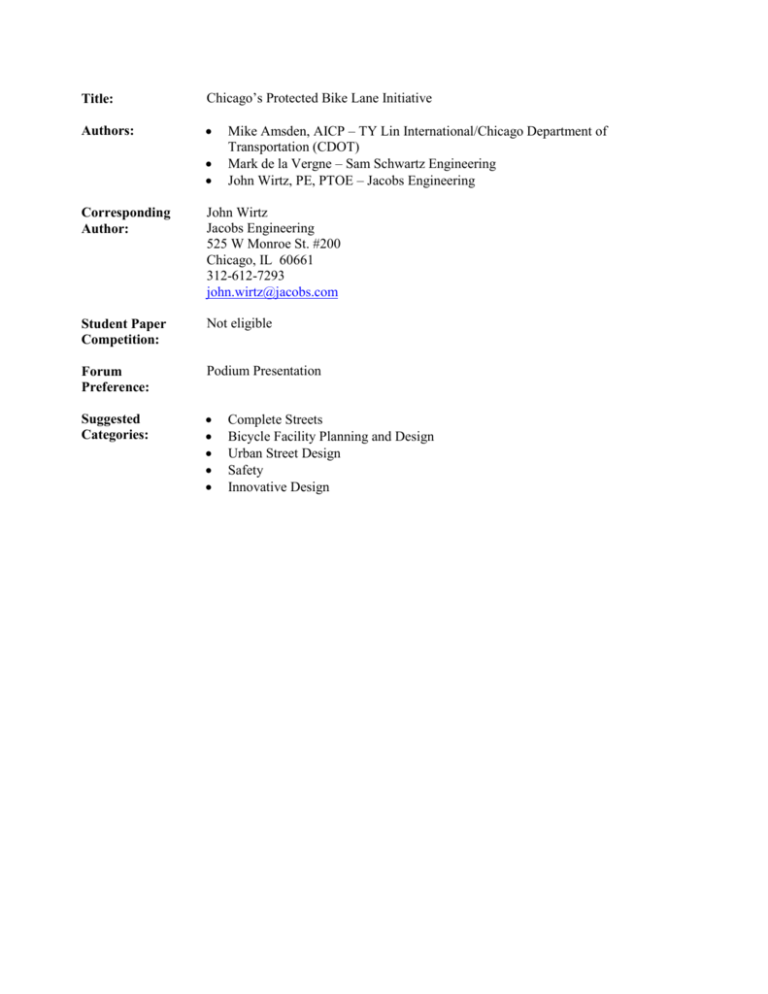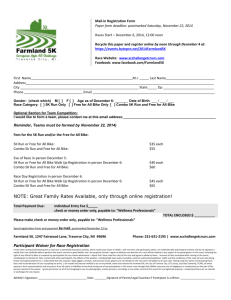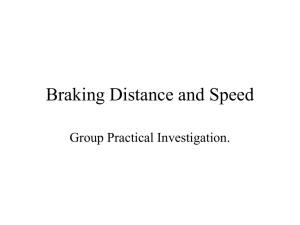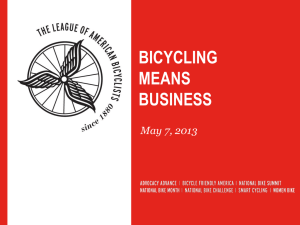Chicago`s Protected Bike Lane Initiative
advertisement

Title: Chicago’s Protected Bike Lane Initiative Authors: Mike Amsden, AICP – TY Lin International/Chicago Department of Transportation (CDOT) Mark de la Vergne – Sam Schwartz Engineering John Wirtz, PE, PTOE – Jacobs Engineering Corresponding Author: John Wirtz Jacobs Engineering 525 W Monroe St. #200 Chicago, IL 60661 312-612-7293 john.wirtz@jacobs.com Student Paper Competition: Not eligible Forum Preference: Podium Presentation Suggested Categories: Complete Streets Bicycle Facility Planning and Design Urban Street Design Safety Innovative Design ABSTRACT Chicago’s Protected Bike Lane Initiative Mayor Rahm Emanuel committed to building 100 miles of protected bike lanes in Chicago by the end of his first term, with the goal of making Chicago the most bicycle-friendly city in the U.S. As part of this initiative, the Chicago Department of Transportation is developing the Streets for Cycling Plan 2020 to identify a network of safe and innovative facilities that will allow Chicago’s youngest and oldest residents to bike comfortably on the city streets. The plan will start by identifying gaps in the existing bicycle network, opportunities for improvement, and implementation challenges. This will be based on a review of existing maps and data, local knowledge, assistance from Community Advisory Group volunteers, and field checks. The plan will include criteria for the design and implementation of treatments such as protected bike lanes, buffered bike lanes, neighborhood greenways, and intersection treatments. The criteria developed, along with extensive public outreach, will provide recommendations for a network of innovative bicycle facilities that reach all corners of the City. The network will be divided into individual projects and prioritized based on a set of weighted evaluation factors. The presentation will summarize the first year of this initiative, highlighting lessons learned and successes achieved. The presenters will also discuss the plan’s findings, recommendations, and results to date, as well as how the plan will guide Chicago as it strives to meet Mayor Emanuel’s goal. PREVIOUS PLANS The City of Chicago has long been recognized as one of the top cities for bicycling in the United States. In 2001, Bicycling Magazine named Chicago the Best Big City for Bicycling and in 2012, the same magazine named Chicago the 5th most bicycle friendly city of all cities with more than 95,000 residents. The goal of becoming America’s most bicycle-friendly city started in 1991 when then Mayor Richard M. Daley formed the Mayor’s Bicycle Advisory Council (MBAC). That goal remains today as Mayor Rahm Emanuel has placed even more emphasis and priority on creating streets that are safe for bicycling for all Chicagoans – from children riding to school to senior citizens riding to the grocery store – since being sworn into office in May 2011. The Chicago Department of Transportation (CDOT) has developed two bike plans since 1992 to help reach this goal. These plans, the Bike 2000 Plan and the Bike 2015 Plan, present goals and strategies covering the five ‘E’s of bicycle planning – engineering, education, enforcement, encouragement, and evaluation. Bike 2000 Plan One of the first accomplishments of MBAC was adopting the Bike 2000 Plan in 1992. The plan did not recommend specific a network of bicycle facilities, but the key recommendation of the plan was to "develop a network of a minimum of 300 miles of bikeways" including on-street bike lanes, signed routes, wide curb lanes, and shared-use trails.1 This plan focused primarily on the installation of on-street bike facilities and included several strategies to leverage support and funding that are still used today. Some of these strategies include: Funding: The City of Chicago successfully secured federal Congestion Mitigation and Air Quality (CMAQ) funds for implementation of the plan. CMAQ funds are still the primary funding source for on-street bike facilities in Chicago. In 2011, the City of Chicago was $40 million in CMAQ funds for the planning, design, and implementation of the Streets for Cycling Plan 2020. Staff: Full-time consultant staff members were hired with federal CMAQ funds to implement the Bike 2000 Plan. CMAQ funds are still used today to staff the CDOT Bicycle Program. Four design engineers and two transportation planners will work full-time to implement the Streets for Cycling Plan 2020. Chicago Bike Map: The Bike 2000 Plan ultimately led to the creation of Chicago’s Bike Map – Streets for Cycling. The Streets for Cycling map identifies existing roadways that are suitable for bicycling, but does not identify a proposed bicycle network or prioritize upcoming bicycle projects. This popular map is updated and re-printed annually, and distributed each June at Chicago’s Bike to Work Day Rally. Bike 2015 Plan In January of 2006, MBAC approved the City of Chicago’s Bike 2015 Plan.2 This plan is Chicago’s vision to make bicycling an integral part of daily life in Chicago. The plan recommends projects, policies, and programs covering a ten-year period to encourage bicycling throughout the city. The Bike 2015 Plan has two overall goals: To increase bicycle use, so that five percent of trips under five miles are made by bike The reduce the number of bicycle injuries by 50 percent from current levels Eight chapters with over 150 specific strategies are presented throughout the plan to achieve these goals. These chapters cover on-street bicycle facility improvements, bicycle parking, education, enforcement, bike/transit integration, marketing, and bicycle messengers. Although the plan recommends treatments for on-street bicycle improvements, specific projects and locations are not included. To date, CDOT and its partner agencies have implemented or are currently implementing close to 100 of the 150 strategies in the plan. The Streets for Cycling Plan 2020 will complement the Bike 2015 Plan and help reach the goals of increasing the number of trips made by bicycle and reducing the number of crashes involving bicycles. EXISTING CONDITIONS The Bike 2000 Plan and Bike 2015 Plan have been instrumental in developing Chicago’s existing network of on-street bicycle facilities. Chicago has 132 miles of bike lanes, 40 miles of marked shared lanes, 240 miles of signed bike routes, and 42 miles of shared-use trails. These facilities have successfully increased bicycle ridership since 2000. U.S. Census and American Community Survey data for commuting to work shows that the percent of bicycle commuters in the City of Chicago more than doubled between 2000 and 2010, from 0.5% to 1.1%, respectively. CDOT also has been conducting bicycle counts at select locations and has seen a tremendous increase in bicycling. For example, a two-hour count at Milwaukee Avenue and Elston Avenue in 2003 saw 150 bicyclists pass through the intersection, whereas in 2012 over 800 bicyclists pass through the intersection during a typical two-hour period. Anecdotally, it is obvious that bicycle ridership has increased as bicyclists are now seen on many of Chicago’s streets at all hours of the day and for a variety of trip purposes. Unfortunately, bicycle crashes have also been on the rise since the mid-2000s. In 2005, there were 1,236 reported bicycle-vehicle crashes in Chicago, and in 2010 there were 1,566 bicycle-vehicle crashes. Figure 1 shows a chart of bicycle crashes in Chicago between 2005 through 2010. 2000 1782 1800 1600 1400 1566 1506 1386 1385 1236 1200 1000 800 600 400 200 0 2005 2006 2007 2008 2009 2010 Figure 1: Bicycle Injury Crashes in the City of Chicago The existing network of bike lanes and marked shared lanes accommodate the “Strong and Fearless” and “Enthused and Confident” bicyclists in Chicago.3 However, they do not provide enough protection and perceived safety to encourage Chicagoans who are “Interested but Concerned” in cycling to ride a bike on city streets. When Mayor Emanuel took office in 2011, he released the Chicago 2011 Transition Plan.4 This plan includes 55 initiatives to promote growth and increase safety throughout Chicago. One of the initiatives is to “create a world-class bike network and increase cycling” by installing 100 miles of protected bike lanes by 2015 and other innovative bike facilities that encourage all Chicagoans to ride a bike. As of May 2012, CDOT had installed 6 miles of protected bike lanes and 2.5 miles of buffered bike lanes and is currently designing over 20 more miles of protected bike lanes, 5 miles of buffered bike lanes, and Chicago’s first neighborhood greenway. STREETS FOR CYCLING PLAN 2020 The Streets for Cycling Plan 2020 will develop Chicago’s first network of proposed bicycle facilities and is one of the most ambitious bicycle plans ever undertaken in the United States. Bold in its vision, yet feasible with respect to implementation, the plan identifies a 600-mile bike network of innovative bicycle facilities to implement Mayor Rahm Emanuel’s vision for all Chicagoans between eight years old and eighty to feel safe and comfortable riding on city streets. The network has three primary goals: Provide a bike facility within ½ mile of every Chicagoan Correlate the mileage of proposed facilities to population density Build more facilities in areas of the city where ridership is high, while establishing a strong backbone of facilities in areas of the city where ridership is currently lower Accomplishing these goals over the next eight years will make Chicago’s streets for all bicyclists and encourage residents of all ages and abilities to bike to their destination. The proposed network is an elaborate vision for bicycling in Chicago, but also consists primarily of proposed routes that can be constructed by 2020. A small number of streets identified in the network may not seem feasible for improved bicycle accommodations at present, but these streets were consistently cited as streets that need to have bicycle accommodations in order for the citywide network to be considered complete. Funding, local support, and willingness to drastically change the character of many of these roadways will be required to implement all projects in the plan. Planning Process Given the large geographic area covered by the City of Chicago, the bicycle network planning process began by dividing the city into nine more manageable geographic sub-areas (see Figure 2). A lead planner was assigned to each sub-area. The first task in planning the network was to assess four types of existing conditions in each geographic sub-area: Destinations – These are places people want to go, including neighborhood business districts, major employment centers, schools, major parks, transit stations, community centers, and more. Barriers – Both point barriers and line barriers that either limit access or are hazardous for bicycle transportation were considered. Point barriers are specific locations that could be marked as a single point on a map (e.g., Figure 2: Streets for Cycling City Sub-Areas intersections, bridges, underpasses). Line barriers are corridors or areas that would be marked on a map with a line or rectangle (e.g., rivers, expressways, certain arterial streets, land uses that limit connectivity). Gaps – Two types of gaps were considered, segment gaps and area gaps. Segment gaps are specific stretches of roadway where added bicycle accommodations would result in greater connectivity. These may be streets or routes on which people feel they need to travel but can’t because there are no safe bike facilities. They could also be safe, great streets that people currently use, but are not designated as official bike routes on the Chicago Streets for Cycling map. Area gaps are neighborhoods or large areas that generally lack bike facilities. Assets – These are the strengths of the bike network; the places that area already safe and comfortable for riders of all ages and abilities. In addition to the information gathered by the project team, a considerable amount of input was received from the public. Four public meetings were held in the winter of 2011/2012, and over 300 people attended and provided feedback on the issues listed above. A Facebook group provided another outlet for community participation and numerous comments were logged for each section of the city. Parallel to the Facebook page, the same information was provided on a city-maintained website (www.chicagobikes.org) to ensure that people without Facebook accounts would be able to receive the same information. But developing a comprehensive bicycle network in a city the size of Chicago requires more than a few public meetings. There is an incredible amount of institutional knowledge of biking in the city’s neighborhoods among the residents that have lived and biked there for decades. In order to take advantage of all this local knowledge, nine Community Advisory Groups (CAGs) were formed, one for each sub-area of the city. Each CAG consisted of two volunteer leaders who organized monthly meetings to obtain input on each phase of the project. The CAGs provided information on destinations, barriers, gaps, and assets in each sub-area from very active local cyclists. The project team used the information about existing conditions to begin planning a network of bicycle facilities that would serve the identified major destinations, cross barriers, close existing gaps in the network, and utilize existing assets. To meet the goals of the Chicago 2011 Transition Plan, the team focused first on innovative bicycle facilities such as protected bike lanes, buffered bike lanes, and neighborhood greenways. A variety of data, experience, and professional judgment was used to determine the streets where different types of facilities would be suitable. The data used included the existing conditions information, street maps, street widths, traffic volumes, traffic controls, and on-street parking demands. Community input received from public meetings and the CAGs was central to the decision making process on which routes to recommend as a part of the bicycle network. The team hosted four meeting with CAG leaders between February and May 2012 to create and review bicycle network recommendations. The CAG leaders were responsible for holding local meetings to get input on preferred streets for neighborhood greenways and protected bike lanes. A draft network was completed in May 2012 and presented to CAG leaders for review. The Network The recommended network consists of three distinct classifications: Bicycle Superhighways, Crosstown Bike Routes, and Neighborhood Bike Routes. The specific design of each route will be determined through the engineering and outreach stages of the plan’s implementation. Each route will be designed with a goal of providing the safest treatment possible, including protected bike lanes, buffered bike lanes, and neighborhood greenways. The overall network consists of over 600 miles of routes and will allow bicyclists in Chicago to access any part of the city safely and efficiently. The project team also analyzed if the overall network provides a facility within ½ mile of every resident (see Figure 7) as well how the network relates to population density (see Figure 8). The following pages provide brief descriptions of each type of route, maps of each type of route, an overall network map, and the network analysis maps. Bicycle Superhighways (60 miles) Chicago will re-create these streets on the most direct routes in and out of the Loop (i.e., the central business district) for bicyclists. These “red carpets” for bicycling will be improved over the next eight years to provide bicyclists with the safest, quickest and most comfortable accommodations possible. This will require a level of creativity and innovation in street design and branding new to the United States. Characteristics of Bicycle Superhighways may include: intersection improvements, colored pavement, pavement reconstruction or resurfacing, traffic signals for bicyclists, more bike parking, wayfinding signage, and route branding (see Figure 4). Specific bike accommodations for individual street segments will be determined through the design and implementation stages of the plan, and the feasibility of the following improvements will be considered, starting from the top: Protected bike lanes (preferred treatment) Two-way protected bike lanes Buffered bike lanes Bike lanes/marked shared lanes As shown in Figure 3, the identified Bicycle Superhighways are Clark Street on the north side, Milwaukee Avenue on the northwest side, Lake Street on the west side, Archer Avenue on the southwest side, Vincennes Avenue on the far south side, King Drive on the south side, and South Chicago Avenue on the southeast side. Bicycle Superhighways in the Loop may include portions of Clark Street, Randolph Street, Wasbash Avenue, and Harrison Street. Figure 3: Recommended Bicycle Superhighways Figure 4: Potential Bicycle Superhighway Characteristics Crosstown Bike Routes (260Miles) These routes will be long, continuous bicycle routes on arterial and collector streets connecting neighborhoods, major destinations, and local bikeways. The majority of the protected and buffered bike lanes in Chicago will be located on Crosstown Bike Routes. Like the Bicycle Superhighways, specific bike accommodations for each street segment will be determined through the design and implementation stages of the plan. The feasibility of the following improvements will be considered, starting from the top: Protected bike lanes (preferred treatment) Two-way protected bike lanes Buffered bike lanes Bike lanes/marked shared lanes Figure 5 shows a map of the recommended Crosstown Bike Routes. Figure 5: Recommended Crosstown Bike Routes Neighborhood Bike Routes (320 Miles) These are noted as neighborhood streets that connect the Bicycle Superhighways and Crosstown Bike Routes. They provide access to local destinations, such as parks, schools, transit, and neighborhood retail, as well as residential areas. Traffic volumes on neighborhood bikeways are lower than those on Bicycle Superhighways or Crosstown Bike Routes. Many of these streets are already conducive to bicycling, so the amount of new infrastructure required may be less extensive than on Bicycle Superhighways or Crosston Bike Routes, but would likely vary from block to block. Each Neighborhood Bike Route should be designed in conjunction with the residents that live along the routes in order to provide streets that are contextually appropriate to each neighborhood. Typical elements of a Neighborhood Bike Route may include changes in traffic control to provide priority to bicyclists and traffic calming to reduce automobile speeds and volumes. Specific bike accommodations will be determined through the design and implementation stages of the plan, and the feasibility of the following improvements will be considered, starting from the top: Neighborhood greenways (preferred treatment) Protected bike lanes Buffered bike lanes Bike lanes/marked shared lanes Signed bike routes Figure 6 shows a map of the recommended Neighborhood Bike Routes. Figure 6: Recommended Neighborhood Bike Routes Figure 7: Residents within ½ Mile of a Recommended Bike Facility Figure 8: Recommended Network Map with Population Density Next Steps A prioritization methodology is currently being developed to identify projects for an annual basis up to the year 2020. It will include input from the public; existing ridership; crash history; proximity to transit, schools, and parks; and other factors still to be identified. A final plan will be released in late summer/early fall 2012. REFERENCES Mayor’s Bicycle Advisory Council. The Bike 2000 Plan. 1992. Available at: http://www.bike2015plan.org/pdf/bike2000plan.pdf 1 Mayor’s Bicycle Advisory Council. Bike 2015 Plan. 2006. Available at: http://www.bike2015plan.org/pdf/bike2015plan.pdf 2 3 Roger Geller, Bicycle Coordinator, Portland Office of Transportation. Four Types of Cyclists. Available at: http://www.portlandonline.com/transportation/index.cfm?&a=237507&c=44597 4 Mayor-Elect Rahm Emanuel Transition Team. Chicago 2011 Transition Plan. 2011. Available at: http://www.cityofchicago.org/dam/city/depts/mayor/supp_info/chicago_2011_transition_report.pdf







